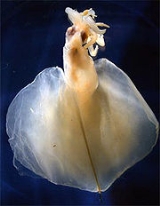
Magnapinna atlantica
Encyclopedia
Magnapinna atlantica, previously known as "Magnapinna sp. A", is a species of bigfin squid
known from only two specimens collected in the northern Atlantic Ocean
. It is characterised by several unique morphological features: the tentacle bases are narrower than adjacent arm bases, the proximal tentacle lacks suckers but possesses glandular structures, and the animal's pigment is contained mostly in functional chromatophore
s.
M. atlantica was described in 2006 by Michael Vecchione and Richard E. Young. The holotype
, deposited in the National Museum of Natural History
(cat. no. USNM 1086800), is an immature female of mantle
length (ML) 59 mm, captured in the Gulf of Mexico
on September 16, 1995 at 27°09′N 86°07′W. This specimen is relatively intact with damage only to the tips of the arms and tentacles. The paratype
, held in the Natural History Museum
(cat. no. BMNH 20060134), is an immature male of 53 mm ML, captured over the Mid-Atlantic Ridge
near the Azores
on June 21, 1997 at 37°14′N 32°18′W.
Bigfin squid
The bigfin squids are a group of rarely seen cephalopods with a distinctive morphology. They are placed in the genus Magnapinna and family Magnapinnidae...
known from only two specimens collected in the northern Atlantic Ocean
Atlantic Ocean
The Atlantic Ocean is the second-largest of the world's oceanic divisions. With a total area of about , it covers approximately 20% of the Earth's surface and about 26% of its water surface area...
. It is characterised by several unique morphological features: the tentacle bases are narrower than adjacent arm bases, the proximal tentacle lacks suckers but possesses glandular structures, and the animal's pigment is contained mostly in functional chromatophore
Chromatophore
Chromatophores are pigment-containing and light-reflecting cells found in amphibians, fish, reptiles, crustaceans, and cephalopods. They are largely responsible for generating skin and eye colour in cold-blooded animals and are generated in the neural crest during embryonic development...
s.
M. atlantica was described in 2006 by Michael Vecchione and Richard E. Young. The holotype
Holotype
A holotype is a single physical example of an organism, known to have been used when the species was formally described. It is either the single such physical example or one of several such, but explicitly designated as the holotype...
, deposited in the National Museum of Natural History
National Museum of Natural History
The National Museum of Natural History is a natural history museum administered by the Smithsonian Institution, located on the National Mall in Washington, D.C., United States. Admission is free and the museum is open 364 days a year....
(cat. no. USNM 1086800), is an immature female of mantle
Mantle (mollusc)
The mantle is a significant part of the anatomy of molluscs: it is the dorsal body wall which covers the visceral mass and usually protrudes in the form of flaps well beyond the visceral mass itself.In many, but by no means all, species of molluscs, the epidermis of the mantle secretes...
length (ML) 59 mm, captured in the Gulf of Mexico
Gulf of Mexico
The Gulf of Mexico is a partially landlocked ocean basin largely surrounded by the North American continent and the island of Cuba. It is bounded on the northeast, north and northwest by the Gulf Coast of the United States, on the southwest and south by Mexico, and on the southeast by Cuba. In...
on September 16, 1995 at 27°09′N 86°07′W. This specimen is relatively intact with damage only to the tips of the arms and tentacles. The paratype
Paratype
Paratype is a technical term used in the scientific naming of species and other taxa of organisms. The exact meaning of the term paratype when it is used in zoology is not the same as the meaning when it is used in botany...
, held in the Natural History Museum
Natural History Museum
The Natural History Museum is one of three large museums on Exhibition Road, South Kensington, London, England . Its main frontage is on Cromwell Road...
(cat. no. BMNH 20060134), is an immature male of 53 mm ML, captured over the Mid-Atlantic Ridge
Mid-Atlantic Ridge
The Mid-Atlantic Ridge is a mid-ocean ridge, a divergent tectonic plate boundary located along the floor of the Atlantic Ocean, and part of the longest mountain range in the world. It separates the Eurasian Plate and North American Plate in the North Atlantic, and the African Plate from the South...
near the Azores
Azores
The Archipelago of the Azores is composed of nine volcanic islands situated in the middle of the North Atlantic Ocean, and is located about west from Lisbon and about east from the east coast of North America. The islands, and their economic exclusion zone, form the Autonomous Region of the...
on June 21, 1997 at 37°14′N 32°18′W.

